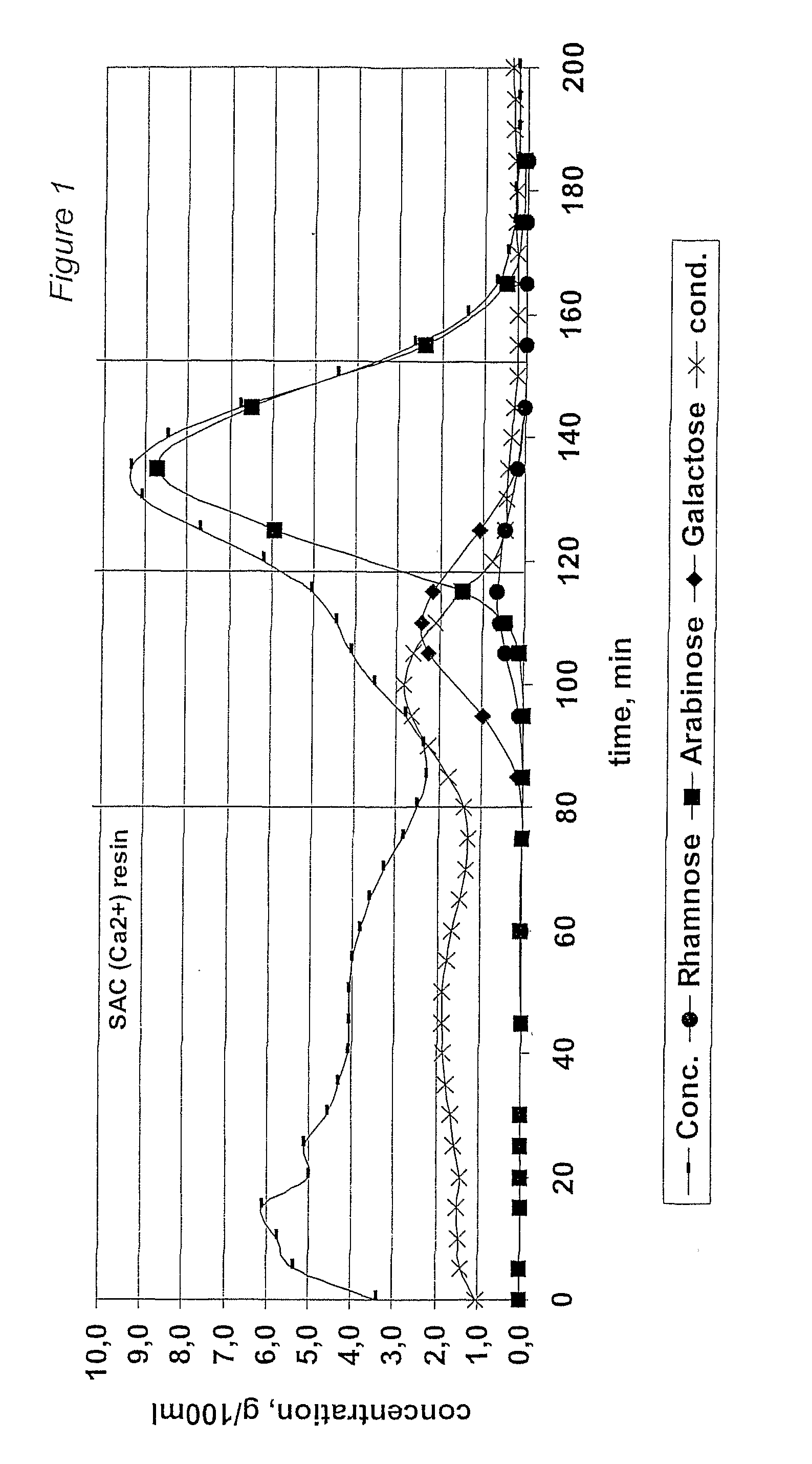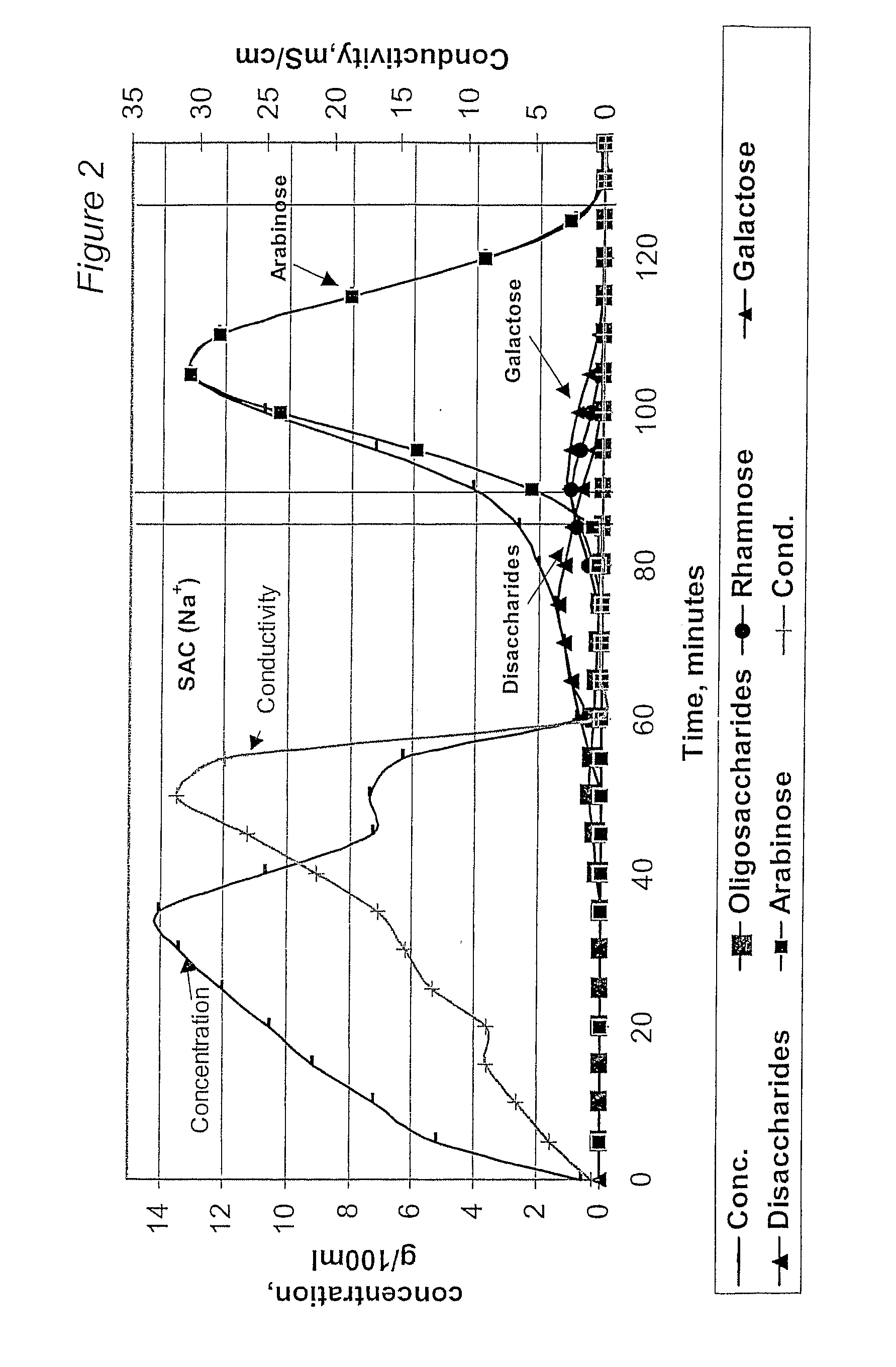Separation process
a separation process and arabinose technology, applied in the field of sugar separation technology, can solve the problems of process disadvantage, process inability to provide sufficient purity, and involvement of organic solvents, and achieve the effects of high purity, high purity and high yield
- Summary
- Abstract
- Description
- Claims
- Application Information
AI Technical Summary
Benefits of technology
Problems solved by technology
Method used
Image
Examples
example 1
Total Hydrolysis of Various Gum Arabic and Gum Ghatti Samples
[0171] The following gum arabic samples were subjected to hydrolysis with H2SO4:
[0172] 1. Gum Arabic, spray dried (Merck 4228.1000)
[0173] 2. Gum Seyal (Valspray F ref. 25500 (Valmar S. A.))
[0174] 3. Valcoat VM / 960 (Valmar S. A.)
[0175] 4. Arabic gum Kibbled 56080 (Valmar S. A.)
[0176] 5. Gum Acacia Seyal, Kibbled (Valmar S. A.)
[0177] Gum arabic sample No. 4 was milled with a hammer mill and screened with a sieve (1 mm). The other gum arabic samples were used as they were. The samples were hydrolyzed at a dry solids concentration of about 5% at a pH of 1 at various temperatures for one to six hours, cooled to room temperature and subjected to analysis.
[0178] The hydrolysis conditions (hydrolysis time and temperature) and the carbohydrate composition of the hydrolysis products after the hydrolysis (expressed as % on the oven-dried (105° C.) dry substance of the gum arabic) are presented in the following table (“oligos...
example 2
Selective Hydrolysis of Gum Arabic and Chromatographic Fractionation of the Gum Arabic Hydrolyzate with a Strongly Acid Cation Exchange Resin in Ca2+ Form.
[0185] (A) Preparation of the Gum Arabic Hydrolyzate:
[0186] 9.25 kg of Gum Arabic Seyal (Valspray, Valmar S / A) was poured into 40 liters of water in a batch reactor. The solution was solubilized over night under agitation. The pH of the gum solution thus obtained was adjusted to 1.07 with 4 kg of 20% H2SO4 and the solution was heated to 95° C. The temperature of the solution was maintained at 94 to 96° C. with gentle agitation. Then the reaction was stopped by cooling the solution to 60° C., followed by neutralizing the solution with 3.12 kg of 20% Ca(OH)2 slurry to a pH of 3.4. The solution was filtered with a Buchner funnel and paper using diatomaceous earth as a filtering aid.
[0187] The sugar content of the hydrolyzate was determined at various stages of hydrolysis as well as after the neutralization. The levels of rhamnose...
example 3
Chromatographic Fractionation of a Gum Arabic Hydrolyzate with a Strongly Acid Cation Exchange Resin in Na+ Form
[0198] The feed solution for the separation was a gum arabic hydrolyzate prepared in accordance with Example 2(A). The hydrolyzate, which mainly contained arabinose, galactose and rhamnose, had been neutralized with Ca(OH)2 and NaOH and filtered with diatomaceous earth.
[0199] The feed solution had the following composition (% on RDS):
Arabinose30.9Galactose2.3Rhamnose1.7Others65.1
[0200] The solution having the composition presented above was subjected to chromatographic separation. The separation was performed in a pilot scale chromatographic separation column as a batch process. The column with a diameter of 0.2 m was filled with a strongly acid cation exchange resin (5.5% DVB). The height of the resin bed was approximately 7.95 m. The average particle size of the resin was 0.35 mm. The resin was regenerated into a sodium (Na+) form. The temperature of the column and ...
PUM
| Property | Measurement | Unit |
|---|---|---|
| temperature | aaaaa | aaaaa |
| melting point | aaaaa | aaaaa |
| melting point | aaaaa | aaaaa |
Abstract
Description
Claims
Application Information
 Login to View More
Login to View More - R&D
- Intellectual Property
- Life Sciences
- Materials
- Tech Scout
- Unparalleled Data Quality
- Higher Quality Content
- 60% Fewer Hallucinations
Browse by: Latest US Patents, China's latest patents, Technical Efficacy Thesaurus, Application Domain, Technology Topic, Popular Technical Reports.
© 2025 PatSnap. All rights reserved.Legal|Privacy policy|Modern Slavery Act Transparency Statement|Sitemap|About US| Contact US: help@patsnap.com



